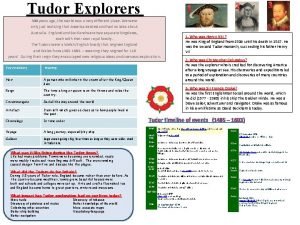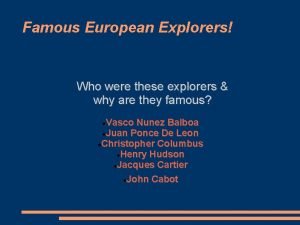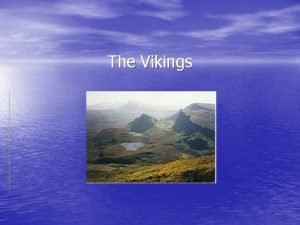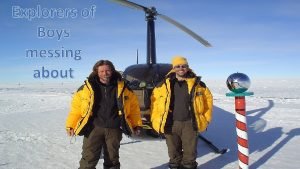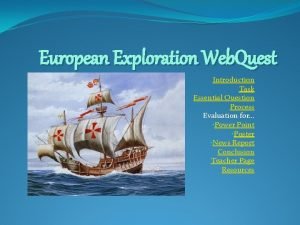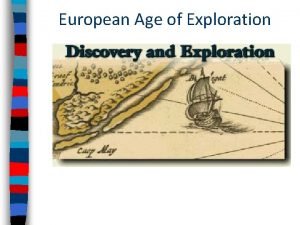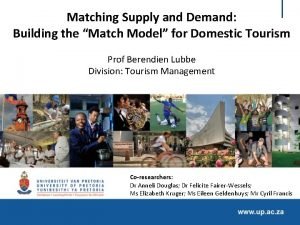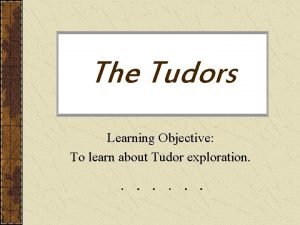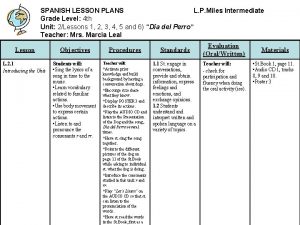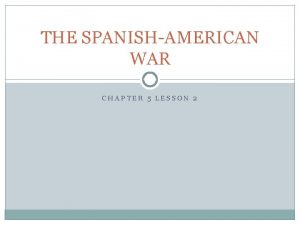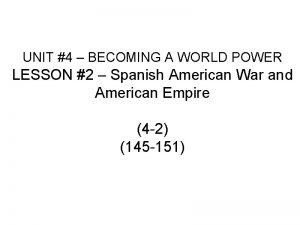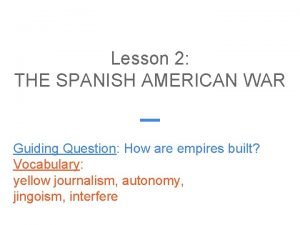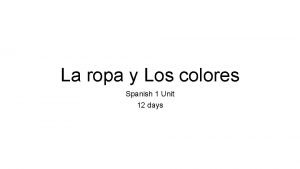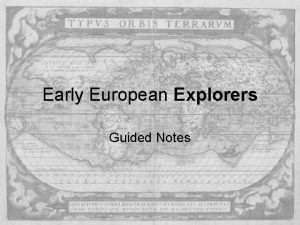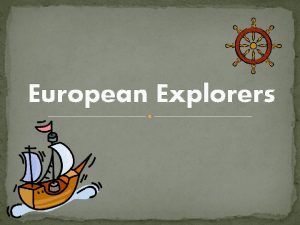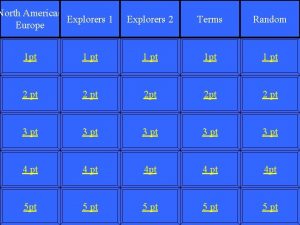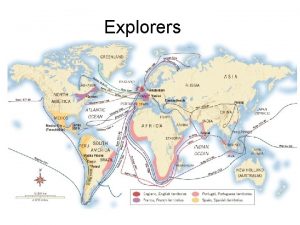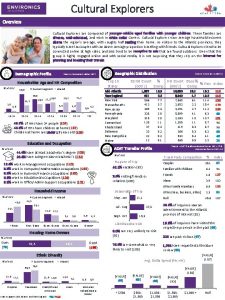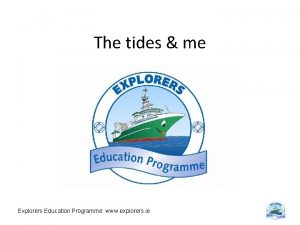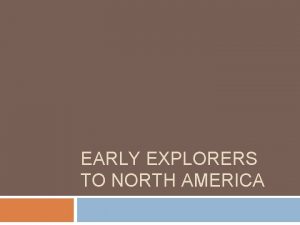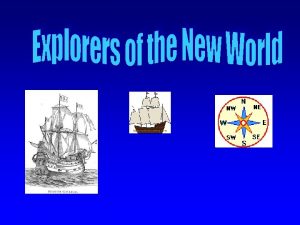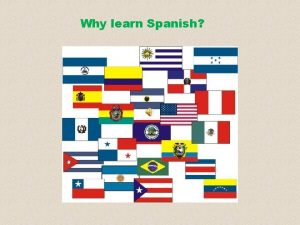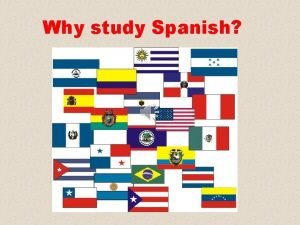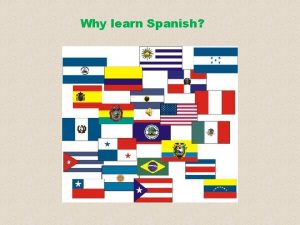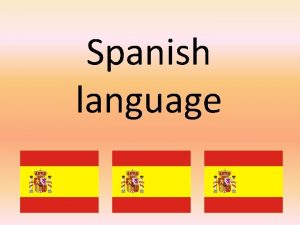The Spanish Explorers Lesson 5 1 Notes The























- Slides: 23

The Spanish Explorers Lesson 5. 1 Notes

The Spanish Discover a “New World” Europeans looked for a new trade route to India and East Asia to avoid the old land routes across the Middle East because the ottomans who controlled the area demanded high fees from traders.

The Age of Exploration: Navigation tools were not accurate enough to enable travel across oceans so sailors had to stay close to the coast. In 1488 Portuguese explorer Bartolomeu Dias sailed along the west coast of Africa indicating there might be a sea route to Asia.

Columbus Reaches the Americas: Columbus left Spain with three small ships in August 1492 to find the new sea route to Asia. On October 12, 1492, Columbus came ashore on a small island in the Caribbean Sea that he had originally though was the West Indies. No one in Europe knew this land or these people existed. They gave him credit for “discovering the new world” but clearly, the indigenous natives living there did not need to be “discovered. ” Even though Columbus was Italian, Spain had funded the expedition so he claimed all of the land its resources for Spain.

The Beginnings of Colonization: In the 1500 s Spain explored much of the southern half of the American mainland, the Caribbean, most of South America and all of Central America and Mexico. With their superior weapons and well-trained Conquistadores, Spain was able to conquer and settle many of these areas to gain wealth and glory for themselves.

Farming and Mapping New Spain: In February 1519, Spanish Conquistador Hernan Cortes landed in what is now called Veracruz, Mexico. He marched into the interior of Mexico and into the capital of the Aztec Empire, Tenochtitlan where he saw the city’s vast collection of gold. He was originally mistaken as an Aztec god – Quetzalcoatl – that they Aztecs believed was scheduled to reappear that year. He gained the trust and faith of the Aztec people and when he had the opportunity, he seized the city by kidnapping the Aztec King, Montezuma and destroying the Aztec army with Spain’s superior weapons.

Farming and Mapping New Spain: He rebuilt the city and named it Mexico City, the capital of New Spain and claimed all of the gold for himself and Spain. Many more people followed Cortes – conquistadors that continued the plunder of other civilizations for gold and glory and Catholic priests and nuns that wanted to convert the Natives to Catholicism with a system of missions.

Alonso Alvarez de Pineda: • 1 n 1519, Pineda became the first European to explore the Texas coast and map the coastline from Florida to Mexico. • He later died in 1520 during a Native uprising in Mexico where he had attempted to start a settlement.

Cabeza de Vaca Meets the Karankawas: • In 1527, Alvar Nunez Cabeza de Vaca is shipped wrecked on the Texas coastline when his original expedition with Panfilo de Narvaez is destroyed by a hurricane. • Panfilo de Narvaez and most of his men die in the Gulf of Mexico when they unknowingly sailed into the middle of a hurricane as they attempted to get from the mainland of North America to their Spanish colony in New Spain.

Cabeza de Vaca Meets the Karankawas: Cabeza de Vaca was among the lucky few how survived the storm and washed ashore on the Texas coastline near present-day Galveston. The Karankawas helped Cabeza de Vaca and the others by building fires and providing them with food - fish and roots to eat. Cabeza de Vaca established himself as a trader and survived by trading goods from Galveston Island with the natives on the mainland.

Cabeza de Vaca Meets the Karankawas: • Eventually, diseases start to hit everyone, including the Karankawa tribe. • In 1535, Cabeza de Vaca and the other survivors from the hurricane left to find a route back to Mexico. In early 1536, they reached a Spanish settlement at Culiacan, Mexico. • Cabeza de Vaca told the stories of his adventures in a book called La Relacion that amazed many Spaniards and even encouraged some of them to go to the New World.

Cabeza de Vaca Meets the Karankawas: In his book, he told stories of huge “cattle” with small horns (bison), and cities of wealth - gold, emeralds, turquois, copper. However, Cabeza de Vaca never saw those wealthy cities but only heard stories of them - these stories inspired other conquistadores to explore the new world in hopes of obtaining these riches. The began an new era in Texas called the Age of Contact that last until 1690 when Spain’s starts its first settlement.

Coronado Explores the Plains: Spain’s highest-ranking official in New Spain, Viceroy Antonio de Mendoza decides to send an expedition to investigate Cabeza de Vaca’s stories of the Seven Cities of gold, also known as Cibola. Coronado Sets out in Search of Gold: Viceroy Mendoza chose Francisco Vasquez de Coronado to lead the expedition to explore and locate Cibola. Coronado brought with him 300 soldiers, cattle, sheep and a large food supply to last them on their 1200 mile journey for Cibola. The Zuni settlement was the first stop on his journey. However, Coronado only found a village made of mud and stone and no gold.

A Failed Mission: • Even though the Zuni village did not provide him with the gold he desired, he continued on to explore the New World. • He divided his men into smaller groups and sent them in different directions. One group saw the Grand Canyon but found no gold. • Eventually, the group Coronado was leading met a Pawnee native called the Turk. He told of a place on the Great Plains called Quivira that was full of wealth and treasure.

Quivira: • The Turk guided Coronado away from the Pawnee village and took him in search for the place called Quivira. The expedition went on and seemed to almost go in circles at times. Eventually, the Turk led Coronado to a place near present day Wichita, Kansas and proclaimed it to be Quivira. • However, no gold was found in Quivira and Coronado was convinced that the Turk had lied to him and sent him on a wild goose chase. Coronado had the Turk put to death for his lies and failure to find gold. • Coronado does send the King word of the good soil in Texas (great for farming)

Other Spanish Explorers: Two other Spanish expeditions will take place in Texas during the 1500 s: Luis de Moscoso and Juan de Onate Moscoso Reaches East Texas: Moscoso was on an expedition led by Hernando de Soto in 1539. De Soto became ill in 1542 and died on the expedition. Moscoso took command began exploring into Texas. Moscoso traveled into East Texas – near Nacogodoches and down to the Guadalupe River before running low on supplies and turning back to find a way back to New Spain (Mexico). He eventually finds the Mississippi River and builds a boat to sail back to Mexico. Before leaving Texas, Moscoso does make a discovery of great importance in today’s world – he found a black, bubbly substance coming from under ground or better known as OIL.

Spaniards Settle on the Rio Grande: • In 1598, Juan de Onate led a huge expedition to start several settlements on the upper Rio Grande River area. • He brought with him 600 people, 83 wagons and 7, 000 animals to start the settlements. • They started several settlements including the city of Santa Fe in 1609. • As the Spanish spread their settlements across the area, they unknowingly brought with them diseases and illnesses that greatly impacted the indigenous people of the area.

La Salle Leads the French into Texas: In the 1600’s, England, France, Spain, Portugal and the Netherlands had established colonies in either North, Central or South America. La Salle Explores the Mississippi: Rene-Robert Cavelier, Sieur de la Salle was the first French explorer to enter the Spain’s territory of Texas. In 1682, he led an expedition south from Michigan down the Illinois and Mississippi Rivers to explore the rivers delta and claim the land for France. La Salle named the area Louisiana after French King Louis XIV.

The French Found Fort St. Louis: La Salle gained the authority from King Louis XIV to start a colony at the mouth of the Mississippi River. La Salle had planned to use the colony as a base to capture silver mines in New Spain. However, he had many problems with the colony from the very beginning: 1. La Salle had arguments with the ship captains 2. One of his ships were captured by a Spanish privateer causing great loss of supplies needed for the journey 3. La Salle was not a skilled navigator and couldn’t find the mouth of the Mississippi River to start the colony so ended up settling in Texas – Garcitas Creek 4. Another ship ends up hitting a sandbar along the Texas coast and becomes stuck in the sand leading to the loss of more supplies

5. One ship returns back to France with settlers that decided not to stay because of all of the problems La Salle encounters 6. La Salle argues with the Karankawas who in retaliation attack the settlement repeatedly or kill settlers out looking for firewood or water. 7. Crops fail leading to starvation 8. Diseases and illness hit the settlement hard killing many people

Fort St. Louis Fails: With no ships, few supplies and fewer than 40 survivors left, La Salle decides he must find help for his settlement and creates a small “rescue” expedition from the strongest remaining colonists. However, several attempts had already been made to find the Mississippi River. He repeatedly took the same route to find the river in each attempt and was unsuccessful every time. He also didn’t seem to want to listen to any advice or guidance from other colonists either. In East Texas, the members of the “rescue” expedition refuse to continue on with their current route. They demand that La Salle listen to them and attempt a new route. La Salle refused and his men rebelled and murdered La Salle on March 19, 1867. Six men led by Henri Joutel continued on and found the Mississippi River and were able to finally reach the French settlement of Quebec.

Henri Joutel pleaded with King Louis XIV to send a rescue expedition back to Fort St. Louis but he refused because he had “wasted enough money” on the colony. Those remaining at Fort St. Louis managed to survive for a while without La Salle or the needed supplies. Around December of 1688, the Karankawas attacked the settlement killing most of the people there. A few of the children’s lives were spared and they were raised by the Karankawas for several years before the Spanish Conquistadors freed them after a short battle.

Spain and France Feud: Even though the French colony failed to survive, it had an impact on the future of Texas. Spain was in constant competition with France in Europe and in constant battles as well. When Spain hears of a French settlement in their territory, they are furious and decide they must do something to secure the area. Spanish explorer Alonso de Leon is sent to locate and destroy Fort St. Louis. However, he finds out that La Salle’s poor planning, navigation and leadership skills led to the settlement’s own destruction. De Leon is able to spend more time to explore the interior areas of Texas and meets the friendly Caddo tribe. The Caddoes are friendly and eager to please him. He believes their friendliness shows an eagerness to convert to Catholicism and with the help of Father Massanet and Father Hidalgo, they build several missions in East Texas. France continues to build settlements in their nearby territory as a challenge to Spain’s control of the area in East Texas.
 Tudor explorers
Tudor explorers Explorers or boys messing about analysis
Explorers or boys messing about analysis Famous european explorers
Famous european explorers Tgcsa logo 5 star
Tgcsa logo 5 star Scandinavian explorers
Scandinavian explorers God glory gold
God glory gold Explorers or boys messing about
Explorers or boys messing about European exploration webquest
European exploration webquest European explorers
European explorers Early explorers timeline
Early explorers timeline Explorers wordly wise
Explorers wordly wise Supply demand matching
Supply demand matching Tudor exploration
Tudor exploration Spanish 1 review packet
Spanish 1 review packet To take notes in spanish
To take notes in spanish Facteur g
Facteur g Spanish lesson plans for intermediate
Spanish lesson plans for intermediate Chapter 5 lesson 2 the spanish american war
Chapter 5 lesson 2 the spanish american war Becoming a world power lesson 2 the spanish american war
Becoming a world power lesson 2 the spanish american war Becoming a world power lesson 2 the spanish american war
Becoming a world power lesson 2 the spanish american war Choose the picture that matches the word la sudadera
Choose the picture that matches the word la sudadera Hình ảnh bộ gõ cơ thể búng tay
Hình ảnh bộ gõ cơ thể búng tay Frameset trong html5
Frameset trong html5 Bổ thể
Bổ thể
